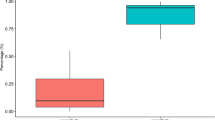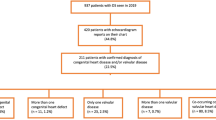Abstract
Background Rheumatic heart disease (RHD) is an important problem in developing countries; however, many cases are detected only when the disease has progressed to cardiac failure. Screening can detect cases earlier, but there are no screening guidelines.
Methods We performed a cross-sectional screening study in Tonga among 5,053 primary school children, in whom auscultation followed by echocardiography of those with heart murmurs were used to identify RHD. We also analyzed whether a three-stage screening protocol of auscultation performed by a medical student to detect any heart murmur, second-stage auscultation performed by a local pediatrician to differentiate pathological from innocent murmurs and echocardiography of those with pathological murmurs altered outcomes.
Results The prevalence of definite RHD was 33.2 per 1,000. The prevalence of RHD increased significantly with age, peaking at 42.6 per 1,000 in children aged 10–12 years. Most valve lesions (91 [54%] of 169) were mild. Auscultation to detect pathological murmurs was poorly sensitive (46.4%), and the finding of any murmur on auscultation did not affect the likelihood of detecting pathology on echocardiography. The finding of a pathological murmur did significantly increase the likelihood of detecting pathology on echocardiography, but still missed 54% of those with pathology (mainly RHD) detected on echocardiography.
Conclusions Screening is a useful method for detecting asymptomatic RHD in regions of high prevalence and we report a high echocardiographically confirmed prevalence. The most appropriate screening strategy remains to be confirmed, however, and implementation will depend on the availability of echocardiography and trained staff.
Key Points
-
The prevalence of echocardiographically confirmed rheumatic heart disease in Tonga is the highest described in the world
-
Auscultatory screening alone missed more than half of pathological valvular lesions compared with echocardiographic screening
-
This study indicates that screening of schoolaged children for rheumatic heart disease by echocardiography might be the most appropriate approach
-
Further work is needed to determine whether echocardiographic screening for rheumatic heart disease can be practical and cost effective in developing countries
This is a preview of subscription content, access via your institution
Access options
Subscribe to this journal
Receive 12 print issues and online access
$209.00 per year
only $17.42 per issue
Buy this article
- Purchase on Springer Link
- Instant access to full article PDF
Prices may be subject to local taxes which are calculated during checkout
Similar content being viewed by others
References
Carapetis JR et al. (2005) The global burden of group A streptococcal diseases. Lancet Infect Dis 5: 685–694
Bisno A et al. Rheumatic fever and rheumatic heart disease: report of a WHO Expert Consultation, Geneva, 29 October–1 November 2001. WHO Technical Report Series; 923. [http://www.who.int/cardiovascular_diseases/resources/en/cvd_trs923.pdf] (accessed 13 February 2008)
Council of Europe (online 10 October 1994) Recommendation No R(94)11 on screening as a tool of preventive medicine. [http://www1.umn.edu/humanrts/instree/coerecr94-11.html] (accessed 4 February 2008)
WHO (1999) The WHO Global Programme for the Prevention of Rheumatic Fever and Rheumatic Heart Disease: Report of a consultation to review progress and develop future activities Geneva, November 29–December 1 [http://whqlibdoc.who.int/hq/2000/WHO_CVD_00.1.pdf] (accessed 13 February 2008)
Jaffe WM et al. (1988) Clinical evaluation versus Doppler echocardiography in the quantitative assessment of valvular heart disease. Circulation 78: 267–275
Agarwal PK et al. (1998) Usefulness of echocardiography in detection of subclinical carditis in acute rheumatic polyarthritis and rheumatic chorea. J Assoc Physicians India 46: 937–938
Anabwani GM and Bonhoeffer P (1996) Prevalence of heart disease in school children in rural Kenya using colour-flow echocardiography. East Afr Med J 73: 215–217
Marijon E et al. (2007) Prevalence of rheumatic heart disease detected by echocardiographic screening. N Engl J Med 357: 470–476
Steer AC et al. (2002) Systematic review of rheumatic heart disease prevalence in children in developing countries: the role of environmental factors. J Paediatr Child Health 38: 229–234
Finau SA et al. (1983) The Tonga 1973 children study: design, demographic aspect and disease prevalence. J Trop Pediatr 29: 201–205
Finau SA and Taylor L (1988) Rheumatic heart disease and school screening: initiatives at an isolated hospital in Tonga. Med J Aust 148: 563–567
Foliaki S WHO Global Programme for the Prevention of Rheumatic Fever/Rheumatic Heart Disease in Sixteen Developing Countries (AGFUND supported): Meeting of National Programme Managers [http://whqlibdoc.who.int/hq/1987/WHO_CVD_87.1.pdf] (accessed 5 February 2008)
Folger GM Jr et al. (1992) Occurrence of valvar heart disease in acute rheumatic fever without evident carditis: colour-flow Doppler identification. Br Heart J 67: 434–438
Wilson NJ and Neutze JM (1995) Echocardiographic diagnosis of subclinical carditis in acute rheumatic fever. Int J Cardiol 50: 1–6
Vasan RS et al. (1996) Echocardiographic evaluation of patients with acute rheumatic fever and rheumatic carditis. Circulation 94: 73–82
Veasy LG et al. (1994) Persistence of acute rheumatic fever in the intermountain area of the United States. J Pediatr 124: 9–16
Carapetis JR et al. Diagnosis and management of acute rheumatic fever and rheumatic heart disease in Australia: An evidence-based review [http://www.heartfoundation.org.au/document/NHF/ arf_rhd_pp-590_diag-mgnt_evidence-review_0606.pdf] (accessed 28 January 2008)
Stata Version 8 (Stata Corp., College Station, TX, USA)
Carapetis JR et al. (2000) Cumulative incidence of rheumatic fever in an endemic region: a guide to the susceptibility of the population? Epidemiol Infect 124: 239–244
Longo-Mbenza B et al. (1998) Survey of rheumatic heart disease in school children of Kinshasa town. Int J Cardiol 63: 287–294
Mukelabai K et al. (2000) Rheumatic heart disease in a sub-Saharan African city: epidemiology, prophylaxis and health education. Cardiologie Tropicale 26: 25–28
Kaplan E (1993) Global assessment of rheumatic fever and rheumatic heart disease at the close of the century: influences and dynamics of populations and pathogens — a failure to realize prevention? Circulation 88: 1964–1972
Agarwal AK et al. (1995) Rheumatic heart disease in India. J R Soc Health 115: 303–304, 309
Aung MTH et al. (1992) Prevalence of cardiovascular diseases in rural area of Hmawbi and urban Yangon city. Asia Pacific J Public Health 6: 188–194
Brown A et al. (2003) Central Australian rheumatic heart disease control program: a report to the Commonwealth November 2002. Northern Territory Disease Control Bulletin 10: 1–8
Rheumatic Fever Working Party (1965) The natural history of rheumatic fever and rheumatic heart disease: ten-year report of a cooperative clinical trial of ACTH, cortisone, and aspirin. Circulation 32: 457–476
Tompkins DG et al. (1972) Long-term prognosis of rheumatic fever patients receiving regular intramuscular benzathine penicillin. Circulation 45: 543–551
Acknowledgements
We thank the Tongan Ministries of Health and Education, the staff of all of the participating schools, and the staff of the hospitals on the islands of Tongatapu, 'Eua and Ha'apai for their support and assistance. W Uahwatanasakul performed second stage auscultation on a number of the children in this study. R Restall and P Kelly assisted in performing echocardiograms. We thank N Wilson for advice regarding echocardiographic methodology and validation. R Andrews provided assistance in data analysis. This study was funded partly by the Australian and New Zealand Children's Heart Research Centre.
Author information
Authors and Affiliations
Corresponding author
Ethics declarations
Competing interests
J Carapetis is a recipient of rheumatic heart disease-related research funding from the Australian National Health and Medical Research Council, the National Heart Foundation of Australia, NIH and numerous other Australian funding bodies, none of which has any vested interest in rheumatic heart disease-related topics. He has undertaken paid rheumatic fever-related consultancy work for the WHO and acted as an unpaid advisor for the NIH. The other authors declared no competing interests.
Rights and permissions
About this article
Cite this article
Carapetis, J., Hardy, M., Fakakovikaetau, T. et al. Evaluation of a screening protocol using auscultation and portable echocardiography to detect asymptomatic rheumatic heart disease in Tongan schoolchildren. Nat Rev Cardiol 5, 411–417 (2008). https://doi.org/10.1038/ncpcardio1185
Received:
Accepted:
Published:
Issue Date:
DOI: https://doi.org/10.1038/ncpcardio1185
This article is cited by
-
2023 World Heart Federation guidelines for the echocardiographic diagnosis of rheumatic heart disease
Nature Reviews Cardiology (2024)
-
Sub-clinical rheumatic heart disease (RHD) detected by hand-held echocardiogram in children participating in a school-based RHD prevention program in Tanzania
BMC Cardiovascular Disorders (2023)
-
Multi-center retrospective cohort study applying deep learning to electrocardiograms to identify left heart valvular dysfunction
Communications Medicine (2023)
-
Prevalence and risk factors for Subclinical Rheumatic Heart Disease among primary school children in Dar es Salaam, Tanzania: a community based cross-sectional study
BMC Cardiovascular Disorders (2021)
-
Prevalence and progression of rheumatic heart disease: a global systematic review and meta-analysis of population-based echocardiographic studies
Scientific Reports (2019)



